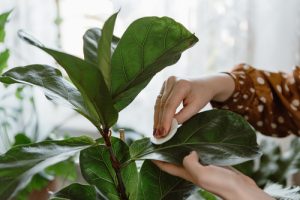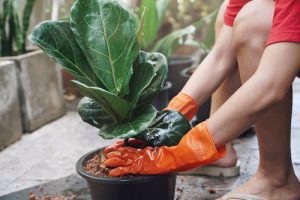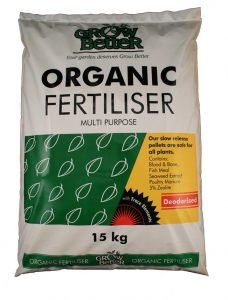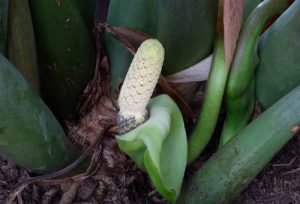With its graceful, almost wand-like stems and waxy, emerald leaves, the Zanzibar Gem is truly a stunning indoor plant. So it’s no wonder that it’s popular as an indoor plant for homes and offices. And with its ability to withstand long periods of drought or neglect, the Zanzibar Gem or ZZ plant has earned the nickname the “eternity plant”. And it makes it the perfect plant for beginner plant owners. Today we are going to discuss the 15 best tips to grow a healthy Zanzibar Gem!
 What is a Zanzibar Gem?
What is a Zanzibar Gem?
ZZ plants are herbaceous plants that can grow between 45-60cm tall. They are generally evergreen plants but they can loose their leaves in drought conditions. ZZ plants have long leaves that grow in 6-8 pairs that a waxy, smooth, glossy, and a dark emerald green. Zanzibar Gems can grow pretty big, and they can even look like trees or palms. This is why they are also often known as Aroid Palms or Emerald Palms. The ZZ plant is even produces flowers from midsummer to the beginning of autumn though they are generally hidden around the base of the leaves. In the past, the Zanzibar Gem was used in medical treatments of earaches, inflammatory conditions, stomach-aches, and ulcers.
15 Best Tips to Grow a Healthy Zanzibar Gem
It is incredibly easy to take care of your beautiful, healthy Zanzibar Gem. Below are our 15 tips to help you take care of your new ZZ plant.

1: Light
A Zanzibar Gem prefers bright to medium indirect light, though they can adjust to low light. If required, the ZZ plant can even survive with just overhead fluorescent lighting in a home or office. But moderate to medium light is key for a healthy Zanzibar Gem. While they can deal with lower light, they don’t have a lot of new growth and the stems tend to stretch. This is what plant owners call a “leggy plant”.
However, if your ZZ plant is placed in the hot sun or against a hot window, they will absolutely burn in no time. As a result, you plant with have ugly yellow and brown, burned leaves. This is why moderate to medium light is the sweet spot for your Zanzibar Gem. It is best to keep them at least 10 feet away from any windows, where possible.

2: Water
Zanzibar Gems are incredible! They can store water in their leaves, stems, and bulbous roots. They can store such a high amount of water that they can survive four months without water. But this isn’t an excuse to neglect your plant. We recommend water around once every week or when the top two inches of the soil is dry. When it comes to your ZZ plant, err on the side of under watering your plant and water less in the winter.

3: Growth
In the perfect conditions, your ZZ plant can grow up to 10 inches every year, eventually reaching around 5 feet in height! This is where it gets its Emerald Palm and Aroid Palm names, because these plants can look like palm fronds as they get bigger. However, in low light, this plant will grow more slowly and become “leggy” resulting in a less than appealing looking plant. We also recommend fertilising your Zanzibar Gem 1-2 times per month over spring and summer with an indoor plant specific plant food or a foliar feed all year round.

4: Pruning
Zanzibar Gems are very low maintenance and basically shape themselves. This means you won’t need to prune it very often. It is important to remove dry or dead leave all year round but don’t do any major pruning until spring or summer. Unlike your other houseplants, pruning a ZZ plant doesn’t promote new growth. So when pruning, only remove unwanted stalks that are unattractive or have been damaged in some way. When pruning your Zanzibar Gem always use sharp, clean shears, and cut at the base of the stalk for the best results.

5: Cleaning
Unlike growing in the wild, Zanzibar Gem plants attract dust when kept indoors, just like everything else in your home. As a result, it is important to keep your ZZ plants as dust-free as everything else in your home. Dust prevents your plant from absorbing sunlight, which is an important aspect of healthy growth. You can clean the leaves regularly with a damp cloth and incorporate a little misting into your routine to decrease dust build-up. You can also put your Zanzibar Gem out in the rain 2-3 times a year or gently hose them off in the shower or the sink if you can’t put your ZZ plant outside.

6: Repotting
Interestingly, indoor plants grow much slower than their cousins who grow in the wild. However, they do grow and as they grow, they new requirements to stay healthy. This includes repotting. ZZ plants generally require potting every 2-3 years. This then provides them with fresh nutrients which encourages new growth. When repotting your Zanzibar Gem it is important to remember that they have very strong root systems and they can actually break through their pots when it is time to repot them! However, ZZ plant roots do prefer to be tightly compacted, so don’t be afraid if the plant is looking a little crowded.
If you want your plant to grow taller, choose a new pot that’s about 2 inches bigger in diameter than the current pot. But if you want it to stay roughly the same size, reuse the same pot – or buy one of the same size – and repot with the same soil. Always water the soil thoroughly after repotting and place the plant in an area with bright, indirect light. It will take your plant 2-4 weeks to overcome the shock and adjust to the new pot.

7: Soil
While you Zanzibar Gem can thrive in normal soil as they aren’t super fussy. You can use a simple, well-draining potting mix. But some plant owners like to do soil mixes to give their ZZ plant the best growth medium possible.
The first option is a good mix of organic potting soil, orchid bark, perlite, and horticultural charcoal. We recommend less bark and more perlite.
they do best in a specially mixed soil that better replicates their natural habitat. We recommend 3 parts potting soil to 1 part succulent and cactus mix. You can also add 1 part coco coir. Some plant owners will also give their ZZ plants a few handfuls of compost and a half layer of worm compost to give the plant some added nutrients.

8: Temperature
If your home is at a comfortable temperature for you, then it’s generally a good temperature for your indoor plants as well. Your Zanzibar Gem grows best between 15 and 23°C with average humidity in the home. It is important to keep your ZZ plant protected and out of temperatures below 7°C. if you live in a drier zone, consider placing a humidifier near your Zanzibar Gem, especially in winter. Make sure you keep it away from any cold drafts as well as air conditioning or heater vents. And if you ZZ plant needs repotting, do it in spring so it has an easier time recovering from the shock of repotting.

9: Humidity
As we mentioned above, ZZ plants love humidity. This is because Zanzibar Gems are native to tropical regions where humidity tends to be higher. However, these plants tend to be very adaptable and can survive in our drier air with only a little brown on their tips. But if you think your ZZ plant is starting to look stressed due to a lack of humidity, there are a few things to do. Like we said earlier, you can buy a humidifier (if you can afford to do so) and place it close to your Zanzibar Gem. You can also fill a plate or pot plant saucer with water and pebbles. Place the plant on top of the pebbles, but make sure the drainage holes aren’t submerged in water. Finally, misting a few times a week should help as well.

10: Fertilising
The Zanzibar Gem isn’t fussy at all when it comes to fertiliser. Most are happy with a handful of compost once a year, if that. If you don’t have access to compost, there are other options. ZZ plants like liquid kelp or fish emulsion or you can choose a balanced, liquid houseplant fertiliser (though it is important you make sure it is 5-5-5 or lower!) It is important that you dilute these to half strength and apply in spring. If you think your plant needs more fertiliser, you can do another half application in summer.
You don’t want to over fertilise your ZZ plant in autumn or winter because this is when the plant is resting. By fertilising at these times you can cause salts to build up and burn the roots of the plants. You should also avoid fertilising a stressed plant or one that is bone dry or soaking wet.

11: Pests
Thankfully healthy Zanzibar Gems are virtually disease free. But it is important to keep an eye open for common indoor plant pests that can infest your plant. These pests include:
- Aphids
- Fungus gnats
- Mealybugs
- Scale
Aphids are the most common pests to watch out for. They are attracted to the sap from your ZZ plant. You will know if you have an aphid infestation if your plant starts to show unusual yellow marks or spots. Aphids easily blend in with the leaves of your plants, so they can be tricky to see. You can treat aphids, as well as the other pests listed above, by wiping the leaves with a mild soap and hot water solution.

12: Toxicity
As beautiful as the ZZ plant is, all parts of the plant are poisonous. It is extremely important that you keep it away from children and pets. When handling your Zanzibar Gem, it is important that you either wear gloves or wash your hands immediately after handling your plant. ZZ plants produce calcium oxalate in all parts of the plant structure, which means no matter where you touch the plant, you come in contact with the calcium oxalate.
Calcium oxalate is a known irritant, which is why most people consider the plant toxic. However, there are only a few ways you can experience adverse side effects from your Zanzibar Gem. The most common effect people experience through skin exposure is an itchy, red, sometimes painful, rash-like symptom on their hands. You can also experience eye issues if your hands have been in contact with the calcium oxalate and you have wiped your eye. This can cause burning, redness, itching, and watery eyes.
If any part of the plant is eaten, this can cause some more severe issues, including vomiting and diarrhea. If the ZZ plant is chewed and/or swallowed, the calcium oxalate crystals can cut and tear the tongue, gums, and soft tissue in the throat. This results in pain, swelling, an upset stomach, and difficulty swallowing.
The above goes for pets as well as people, and if side effects or symptoms get worse at any time, it is important to seek out the help and advice of a doctor or vet, depending on which is required.
Finally, there was a rumour a few years ago that the Zanzibar Gem was so toxic that it could cause cancer. This was proved false by several scientific studies, so there’s no need to fear your gorgeous ZZ Plant.

13: Propagating ZZ Plants
If you want to propagate your ZZ plant to gift a plant to a friend or simply to have more beautiful ZZ plants in your home, then you can do so in two ways. You can either divide the rhizomes and plant them in different pots, or you can propagate from leaf cutting.
If you decide to propagate your healthy Zanzibar Gem from leaf cuttings, it can take up to a year for cuttings to start developing roots, even if you have them in the ideal climate. Although not entirely necessary, once the leaf cuttings have roots and are ready to plant, you can plant them in composted soil with a light amount of fertiliser. This can help speed up root development. Extra light is not required as it stimulates the growth of leaves, not roots, and only improves their glossy exterior.

14: ZZ Plant Flowers
Believe it or not, ZZ plants are an actual flowering plant. In general, it only produces flowers when planted outside. However, very rarely, it will bloom indoors. A healthy Zanzibar Gem can produce little white, spathe-type flowers near the base of the stalk. They are usually hidden by the foliage. The flowers are very similar to those of a peace lily, producing spadix-type flowers.
Unlike other arums, the ZZ plant has a unique reproductive system. Instead of reproducing with pollen, the Zanzibar Gem’s fallen leaflets can take root, forming new plants.

15: Common Problems with Zanzibar Gems
One of the most common problems you can have with a ZZ plant is how much water the plant gets. If the leaves are dropping, your plant is extremely dray and needs water. Are the leaves turning yellow and dropping at the same time? This means your plant is getting too much water. If the top 3 inches of soil is dry, then your plant is ready for water. Are just a few lower leaves turning yellow and falling off? This is generally normal – just check that you’re not overwatering.
If the leaf tips are turning brown, the plant is likely too dry and in low humidity. Misting the leaves, using a humidifier, or the saucer of water and pebbles. Finally, if the leaves are turning brown, overwatering the most common issue, especially if the leaflets feel a bit damp and not dry.
Looking for your perfect Zanzibar Gem? Come down to your local Aumanns Nursery & Garden Centre today! Our team can help you find the perfect plant to suit your home and how to keep your Zanzibar Gem healthy!

